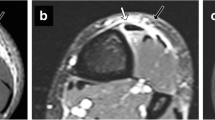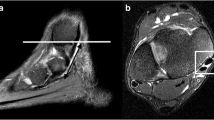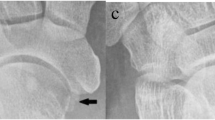Abstract
Objective
Fluid along the frondiform ligament, the sinus tarsi stem of the inferior extensor retinaculum (IER), can approximate the extensor digitorum longus (EDL), at times simulating tenosynovitis. Our purpose, based on MRI and cadaveric studies, was to further evaluate this scantly described phenomenon, to identify associated findings and to alert the radiologists to the potential pitfall of over diagnosing EDL tenosynovitis.
Materials and methods
Two musculoskeletal radiologists retrospectively reviewed the radiology reports and MRI studies of 258 ankle MRI exams, performed at our institution, for fluid along the frondiform ligament extending toward the EDL. No patient had EDL pathology clinically. MRI was performed in two cadaveric ankles following injection of the sinus tarsi and EDL tendon sheath, under ultrasound guidance.
Results
Altogether, 31 MRIs demonstrated fluid extending from the sinus tarsi along the frondiform ligament toward the EDL. In 30 cases (97 %), the fluid partially surrounded the tendon, without tendon sheath distension. Based on the radiology reports, in 11 of the 31 cases (35 %), the fluid was misinterpreted as abnormal. Most common associated findings included ligamentous injury, posterior tibial tendon (PTT) tear, flat-foot, and osteoarthrosis. In the cadavers, fluid extended along the frondiform ligament toward the EDL after sinus tarsi injection; there was no communication between EDL tendon sheath and the sinus tarsi.
Conclusion
Fluid within the sinus tarsi can extend along the frondiform ligament and partially surround the EDL, manifesting as pseudotenosynovitis. This phenomenon, often seen with ligamentous tears or PTT dysfunction, should not be misdiagnosed as true pathology of the EDL.








Similar content being viewed by others
References
Gray H, Goss CM. Anatomy of the human body. Twenty-eighth edition. Philadelphia: Lea & Febiger; 1966.
Last RJ. Specimens from the Hunterian collection. J Bone Joint Surg. 1952;34(B):116–9.
Smith JW. The ligamentous structures in the canalis and sinus tarsi. J Anat. 1958;92(4):616–20.
Kelikian AS, Sarrafian SK. Sarrafian’s anatomy of the foot and ankle: descriptive, topographic, functional. Third edition. Philadelphia: Lippincott Williams & Wilkins; 2011.
Bishop GW, Fallon KE. Musculoskeletal injuries in a six-day track race: ultramarathoner’s ankle. Clin J Sports Med. 1999;9(4):216–20.
Kobayashi H, Sakurai M, Kobayashi T. Extensor digitorum longus tenosynovitis caused by talar head impingement in an ultramarathon runner: a case report. J Orthop Surg. 2007;15(2):245–7.
Perlman MD, Leveille D. Extensor digitorum longus stenosing tenosynovitis: a case report. J Am Podiatr Med Assoc. 1988;78(4):198–9.
Fallon KE. Musculoskeletal injuries in the ultramarathon: the 1990 Westfield Sydney to Melbourne run. Br J Sports Med. 1996;30(4):319–23.
Hutson MA. Medical implications of ultra marathon running: observations of a six day track race. Br J Sports Med. 1984;18(1):44–5.
Moore TE, Yuh WT, Kathol MH, el-Khoury GY, Corson JD. Abnormalities of the foot in patients with diabetes mellitus: findings on MR imaging. Am J Roentgenol. 1991;157(4):813–6.
Nyska M, Sperber AD, Howard CB, Nyska A, Dekel S. Ankle extensor tendon synovitis due to a date palm thorn. Foot Ankle. 1989;10(3):180–3.
Bauer JS, Muller D, Sauerschnig M, Imhoff AB, Rechl H, Rummeny EJ, et al. Ganglia of the tarsal sinus: MR imaging features and clinical findings. Eur J Radiol. 2011;80(3):394–400.
Lovell AGH, Tanner HH. Synovial membranes, with special reference to those related to the tendons of the foot and ankle. J Anat Physiol. 1908;42(4):415–32.
Ng JM, Rosenberg ZS, Bencardino JT, Restrepo-Velez Z, Ciavarra GA, Adler RS. US and MR imaging of the extensor compartment of the ankle. Radiographics. 2013;33(7):2047–64.
Kijowski R, De Smet A, Mukharjee R. Magnetic resonance imaging findings in patients with peroneal tendinopathy and peroneal tenosynovitis. Skelet Radiol. 2007;36(2):105–14.
Anderson MW, Kaplan PA, Dussault RG, Hurwitz S. Association of posterior tibial tendon abnormalities with abnormal signal intensity in the sinus tarsi on MR imaging. Skelet Radiol. 2000;29(9):514–9.
Deland JT, de Asla RJ, Sung IH, Ernberg LA, Potter HG. Posterior tibial tendon insufficiency: which ligaments are involved? Foot Ankle Int. 2005;26(6):427–35.
Author information
Authors and Affiliations
Corresponding author
Ethics declarations
Conflict of interest
No conflicts of interest.
Rights and permissions
About this article
Cite this article
Zember, J., Rosenberg, Z., Rossi, I. et al. The frondiform ligament and pseudotenosynovitis of the extensor digitorum longus tendon: MRI evaluation with cadaveric correlation. Skeletal Radiol 45, 1089–1095 (2016). https://doi.org/10.1007/s00256-016-2395-6
Received:
Revised:
Accepted:
Published:
Issue Date:
DOI: https://doi.org/10.1007/s00256-016-2395-6




